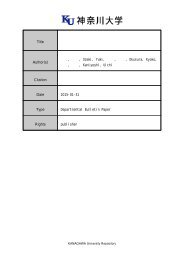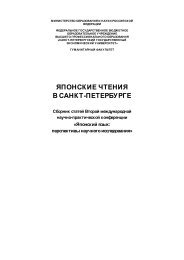to Learners with Special Educational Needs
e-textbook SEN
e-textbook SEN
You also want an ePaper? Increase the reach of your titles
YUMPU automatically turns print PDFs into web optimized ePapers that Google loves.
Pokrivčáková, S. et al. (2015). Teaching Foreign Languages <strong>to</strong> <strong>Learners</strong> <strong>with</strong> <strong>Special</strong> <strong>Educational</strong> <strong>Needs</strong>:<br />
e-textbook for foreign language teachers. Nitra: Constantine the Philosopher University. 128 p.<br />
ISBN 978-80-558-0941-0<br />
method that is highly pedocentric and where the pupil/student is in the centre of the<br />
learning/teaching process. The pupil is viewed as an individual <strong>with</strong> his/her own needs,<br />
interests, knowledge, skills, attitudes, and values. The centre of interest is taking care of the<br />
teaching/learning process, its quality in the relation of every individual child, his/her<br />
possibilities. It is a process where the child is an active co-crea<strong>to</strong>r of the learning<br />
situation/process (see Marušák, Králová, & Rodriguezová, 2008).<br />
The aim of the lesson for an EFL teacher is generally <strong>to</strong> work <strong>with</strong> the language developing all<br />
four language skills (i.e. listening, speaking, reading, and writing); Alan Maley and Alan Duff state<br />
that the main reason why <strong>to</strong> use drama in an EFL classroom is the fact that it integrates skills in<br />
a natural way and that listening is a key feature of it, furthermore, what is important for SEN<br />
learners, is the focus on bringing <strong>to</strong>gether body and mind in integrating verbal and non-verbal<br />
communication, integrating both the cognitive and affective domains, thus res<strong>to</strong>ring the<br />
importance of feeling as well as thinking (Goleman, 1995), by contextualising the language, we<br />
bring the classroom interaction <strong>to</strong> life through focus on meaning <strong>with</strong> the emphasis on wholeperson<br />
learning and multi-sensory inputs, which helps learners and offers them unequalled<br />
opportunities for catering their differences (Maley & Duff, 2007). Bearing in mind that SEN<br />
learners often face failure in the EFL classroom, the main benefit in using drama techniques in<br />
the EFL classroom seem <strong>to</strong> be the focus on building the lerners´ confidence, improving their<br />
spontaineity and fluency in real life situations and not focusing so much on accuracy and<br />
mistakes either in oral production or in writing. Thus providing them <strong>with</strong> the possibilities <strong>to</strong><br />
succeed and not <strong>to</strong> succumb <strong>to</strong> helplesness due <strong>to</strong> their frequent failures.<br />
Fleming in his book Starting Drama Teaching speaks of two main aims when teaching drama<br />
“<strong>to</strong> develop personal qualities” and “<strong>to</strong> develop appreciation of the cultural heritage”,<br />
which at first sight might suggest very different orientations – the first implying the emphasis<br />
on active participation in making drama, the second suggesting a study of texts of different<br />
sorts (Fleming, 2011), which is what we seek for when working <strong>with</strong> SEN learners trying <strong>to</strong><br />
involve them as fully as possible, trying <strong>to</strong> develop their awareness of their strength and<br />
weaknesses and <strong>to</strong> develop their metacognitive and compensa<strong>to</strong>ry skills when working <strong>with</strong> a<br />
<strong>to</strong>pic or text in the context of the EFL classroom. Fleming, besides the two main aims mentioned<br />
above, lists more aims which can be considered as very helpful for SEN children and their wellbeing<br />
in an EFL classroom:<br />
<strong>to</strong> provide future artists and audiences;<br />
<strong>to</strong> help pupils think;<br />
<strong>to</strong> develop personal qualities;<br />
<strong>to</strong> develop imagination and creativity;<br />
<strong>to</strong> provide insight in<strong>to</strong> human situations;<br />
<strong>to</strong> improve teaching other subjects;<br />
<strong>to</strong> educate the emotions;<br />
<strong>to</strong> develop confidence;<br />
<strong>to</strong> provide entertainment and relaxation;<br />
<strong>to</strong> develop appreciation of the cultural heritage;<br />
<strong>to</strong> develop understanding of how drama works as a genre (Fleming, 2011)<br />
Neelands and Good (2008) provided teachers <strong>with</strong> a very useful handbook of available forms<br />
in theatre and drama, which they divided in<strong>to</strong> 4 parts:<br />
a) Context-Building Action (circle of life, circular drama, collective character, collective<br />
drawing, defining space, diaries, letters, journal, messages, games, guided <strong>to</strong>ur, making<br />
maps/diagrams, objects of character, role-on-the-wall, simulations, soundtracking, still<br />
image, the ripple, unfinished materials);<br />
b) Narrative Action ( a day in the life, critical events, hot-seating, interviews/interrogations,<br />
mantle of the expert, meetings, noises off, overheard conversations, reportage, tag role,<br />
teacher-in-role, telephone/radio conversations, time line);<br />
102






